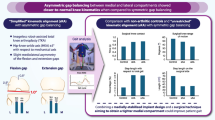Abstract
Purpose
We investigated the contact pressure and area of the patellofemoral joint both before and after different meniscectomies to provide a biomechanical basis for selecting meniscectomy and its clinical application for meniscus injuries.
Methods
Six fresh cadaveric knees were used in the study. Using Staubli robots and an ultra-low-min-type pressure-sensitive tablet, changes in contact area and stress in the patellofemoral joint were measured at various flexion angles following different parts and degrees of meniscectomy.
Results
The patellofemoral contact area enlarged with the increase of knee flexion angle. From the values obtained from contact areas and average contact pressure of the patellofemoral joint, we found no significant difference between partial meniscectomy and intact knees, but a significant difference was found between total meniscectomy and intact knees. The contact area after lateral meniscectomy was statistically less than that of intact knees. The mean patellofemoral contact pressure after lateral meniscectomy was larger than in intact knees at each angle of flexion. No significant difference in contact area was observed between intact knees and medial meniscectomy. The average patellofemoral contact pressure after medial meniscectomy was larger than in intact knees from 0° ~ 30° of knee flexion, and no significant differences were found between intact knees and medial meniscectomy while knee bending from 60° to 90°.
Conclusions
Different meniscectomies result in high contact pressure or disordered distribution of contact pressure, which may be the cause of postoperative patellofemoral degenerative arthrosis.




Similar content being viewed by others
References
Cole BJ, Cartwe AT, Rodeo SA (2002) Allograft Meniscal Transplantation Background, Techniques, and results. J Bone Joint Surg Br 84:1235–1250
Cox JS, Nye CE, Schaefer WW, et al. (1975) The degenerative effects of partial and total resection of the medial meniscus in dogs' knees. Clin Orthop Relat Res 178–183
Hinman RS, Crossley KM (2007) Patellofemoral joint osteoarthritis: an important subgroup of knee osteoarthritis. Rheumatology (Oxford) 46:1057–1062
Kalichman L, Zhang Y, Niu J et al (2007) The association between patellar alignment and patellofemoral joint osteoarthritis features—an MRI study. Rheumatology 46:1303–1308
Li G, Papannagari R, DeFrate LE et al (2006) Comparison of the ACL and ACL graft forces before and after ACL reconstruction: an in-vitro robotic investigation. Acta Orthop 77:267–274
Li G, Papannagari R, DeFrate LE et al (2007) The effects of ACL deficiency on mediolateral translation and varus-valgus rotation. Acta Orthop 78:355–360
Tang Z, Sun ZQ, Zhou CG (2007) Reference trajectory generation for 3-dimensionalwalking of a humanoid robot. Tsinghua Sci Technol 12:577–584
Ihn JC, Kim SJ, Park IH (1993) In vitro study of contact area and pressure distribution in the human knee after partial and total meniscectomy. Int Orthop 17:214–218
Powers CM, Lilley JC, Lee T (1998) The effects of axial and multi-plane loading of the extensor mechanism on the patellofemoral joint. Clin Biomech 13:616–624
Wickiewitz TL, Roy RR, Powell P et al (1983) Muscle architecture of the human lower limb. Clin Orthop Relat Res 179:275–283
Schutzer SF, Ramsby GR, Fulkerson JP (1986) The evaluation of patellofemoral pain using computerized tomography: a p reliminary study. Clin Orthop Relat Res 204:286–293
Englund M, Lohmander LS (2005) Patellofemoral osteoarthritis coexistent with tibiofemoral osteoarthritis in a meniscectomy population. Ann Rheum Dis 64:1721–1726
Mow VC, Ratcliffe A, Poole AR (1992) Cartilage and diarthrodial joints as paradigms for hierarchical materials and structures. Biomaterials 13:67–69
Financial disclosure
The authors gratefully acknowledge the National Natural Science Foundation of China (30570458) for the financial support of this research project.
Conflict of interest
None of the authors have any financial interest in any products, devices or drugs used in this study. There is no conflict of interest related to any commercial association or financial relationship (consultancy, stock ownership, equity interest, patent licensing arrangements or payments for conducting or publicising the study contained in the manuscript).
Author information
Authors and Affiliations
Corresponding author
Rights and permissions
About this article
Cite this article
Bai, B., Shun, H., Yin, Z.X. et al. Changes of contact pressure and area in patellofemoral joint after different meniscectomies. International Orthopaedics (SICOT) 36, 987–991 (2012). https://doi.org/10.1007/s00264-011-1450-0
Received:
Accepted:
Published:
Issue Date:
DOI: https://doi.org/10.1007/s00264-011-1450-0




